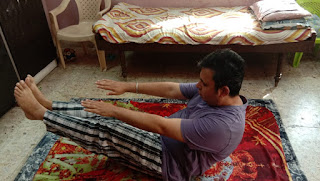Kapalbhati Pranayam – Steps and Benefits
Kapalbhati Pranayam – Steps and Benefits
Kapal means forehead. Bhati means shining and Pranayama means control of breath.
Kapalbhati pranayama is a very powerful breathing exercise that not just helps us lose weight but also brings our entire system into a perfect balance.
When we do pranayama 80% of the toxins of our body are released through the outgoing breath. Regular practice of Kapalbhati pranayama detoxifies all the systems our body.
Kapalbhati means shining forehead. This is what happens when we do practice it regularly. Our forehead glows and intellect becomes sharp, refined with regular practice.
How to do Kapalbhati Pranayama
- Sit comfortably with spine erect in Vajrasana or any comfortable sitting pose. Place hands on the knees (if sitting in sukhasana)or thighs(if sitting in vajrasana).
- Take a deep breath. Exhale continuously through the nose. As you exhale the stomach goes in. Exhalation should be forceful and active. Inhalation happens automatically. Concentrate on exhaling air out.
- Take 20 such breaths for beginning.
- Relax with your eyes closed and observe the sensations in your body.
- If you are comfortable do 3 rounds of 20 breaths each.
- This Pranayam should be done on an empty stomach only or 3-4 hours after eating something. Eat after 30 minutes of doing this breathing exercise.
Benefits of Kapalbhati Pranayam
- Kapalbhati pranayam increases metabolic rate and helps in weight loss.
- It clears the subtle energy channels or nadis.
- This pranayam stimulates abdominal organs, so it is extremely useful for those with diabetes.
- It improves blood circulation and adds glow to the face.
- It improves digestive tract functioning, absorption and digestion of nutrients.
- It energizes the nervous system and rejuvenates brain cells.
- It calms and uplifts the mind.
Who Should Avoid Kapalbhati Pranayam
Avoid practicing this breathing technique, if you have an artificial pacemaker or stent, epilepsy, hernia, backache due to slip disc or have recently undergone abdominal surgery.
Women should not practice Kapalbhati during or shortly after pregnancy. Neither should they do it during menstruation as it involves intense abdominal squeezes.
People with hypertension and heart problems should practice Kapal Bhati under a yoga expert’s guidance. It helps to develop the mind and body but is not a substitute for medicine.
Learn and practice yoga under the supervision of a trained Yoga teacher initially. Later on it can be practiced independently. People who have medical conditions should do yoga after consulting doctor.
Also Read: Bhastrika Pranayama , Benefits of Walking ,Anulom Vilom Pranayam , Brahmari Pranayama , OM Chanting
Also Read: Bhastrika Pranayama , Benefits of Walking ,Anulom Vilom Pranayam , Brahmari Pranayama , OM Chanting



Comments
Post a Comment